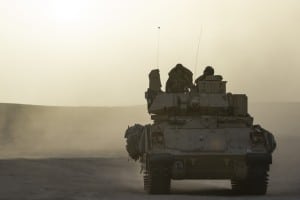The Army on Wednesday held a virtual industry day for its rebooted Optionally Manned Fighting Vehicle (OMFV) competition ahead of the release of a final Request for Proposals (RFP) on Dec. 18, offering expanded details on the program’s desired characteristics and contract award plans.
Officials said each of the up to five contracts awarded in June 2021 for OMFV Phase 2, which calls for industry to prove digital design prototypes, will be worth $61.6 million and cover 15 months of work, according to slides from the industry day.

“As we enter Phase 2, the Concept Design phase, for OMFV, inclusive feedback and innovative thinking from industry remains key,” Brig. Gen. Glenn Dean, the Army’s program executive officer for Ground Combat Systems, said in a statement. “We received tremendous feedback from Industry on the draft RFP released in July, and we have made significant changes as a result of that feedback.”
Earlier this year, the Army canceled the original acquisition effort for the Bradley replacement program, which faced scrutiny after a single bid sample from General Dynamics [GD] was accepted for the program’s prototype phase.
A first unit equipped date for OMFV is planned for an Infantry Battalion for the second quarter of fiscal year 2029.
The Army said it received 500 industry comments on the draft RFP as it aims to “maximize industry innovation while also reducing the burden and cost to industry for participation.”
“The RFP for the Concept Design phase reflects a reduction in scope and deliverables commensurate with the maturity of requirements at the outset, and lays the foundation for subsequent phases with respect to open architecture and modern engineering practices,” Dean said.
The industry day shed more light on the nine vehicle characteristics, rather than more binding requirements, that the Army is using to shape OMFV development, placing survivability and mobility as the top two highest priorities.
“The OMFV shall be survivable against modern direct fire, indirect fire, and blast threats. The OMFV should reduce likelihood of detection by minimizing thermal, visual, and acoustic signatures,” officials wrote in the industry day slides. “The OMFV must have mobility that can keep pace with the Abrams in a combined arms fight through rural and urban terrain.”
Army officials also highlighted the importance of open architecture to allow for “rapid upgrades and insertion of future technologies,” and noting the service is planning to start a consortium with academia and industry in January to begin development of a government-owned architecture.
“The OMFV requires a Modular Open Systems Approach (MOSA) – it is critical to the long term success of the OMFV. Implementation of a MOSA will ensure the program can avoid major redesigns or re-architecting the systems, subsystems or large portions thereof to address evolving requirements and threats, system upgrades, technology insertions, and to address obsolescence and avoid vendor lock,” according to the industry day slides.
For the lethality characteristic, the Army said OMFV-equipped platoons must be able to defeat “future near-peer soldiers, infantry fighting vehicles, helicopters, small unmanned aerial systems, and tanks as part of a Combined Arms Team in rural and urban terrain.”
The Army also wants industry to ensure advanced manufacturing is considered in OMFV prototype designs to assist with logistics and noting all training components must be compatible with the future Synthetic Training Environment.
Proposals to the final RFP are due by March 19, according to the Army.